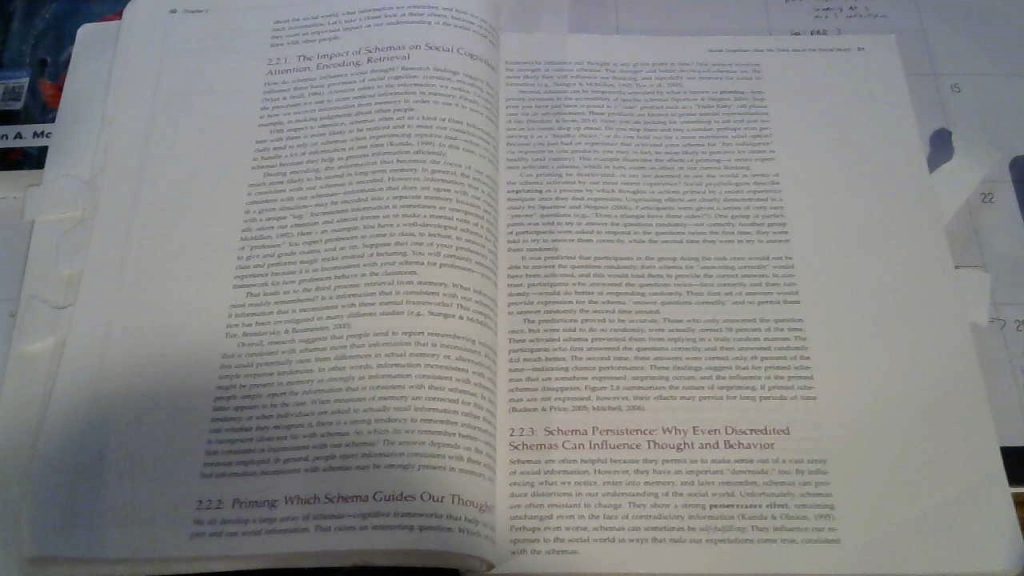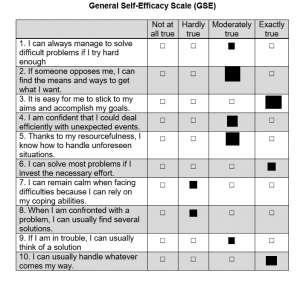Weekly Blog
Blog 10
Looking back at the first blog for this class, I said that I hoped to learn in-group/out-group interactions and we did learn a little about that so that made me happy. I’m continuously thankful for the classes like this that put a fudge factor in the assignments because life gets in the way sometimes, maybe now more than ever. I think the objective I’ve achieved the most thoroughly is the one about tying information to other classes and outside experiences, due in no small part to these blogs where it’s a requirement to do so.
I didn’t really have any kind of impression of social psychology going into this course, and honestly I’m still somewhat unsure of it. I think a lot of what we learned has been information closer to what I learned in my sociology classes although I guess sociology could just be a different way of looking at social psychology. If I had to take this class again, I don’t know that I’d do anything different really. I might study some topics harder or do some work a little further from the deadline, but I wouldn’t make any drastic changes.
I think one skill that I have honed, because we all have this skill, is introspection. Being able to look critically at yourself and your thought processes is a valuable skill in the workplace for several reasons, not least of which is being able to figure out what you may have done wrong and how to correct it. Another bonus is that if you can understand why you made a decision, it can help give some insight into why someone in a similar position may have made the decision they made, and I think that’s valuable if you’re working as a team.
I chose a picture of a reinforced wall as a representation of my academic growth this semester because I think that’s what this class has really done: reinforce. I said earlier on in the class that many things we were learning had been touched upon in different classes that I’ve taken in my school career, and to learn them again with additional context and in a slightly different way reinforces the learning that’s already been done on that topic.

Blog 9
One of the most interesting things that I think we’ve learned about was the blog we wrote about the way ads have become more sexual over time. I like this topic because it really makes you look at some of the advertisements we see every day and examine exactly how they’re trying to appeal to you to get you to buy the products. I think a good tie-in with this topic was the most recent topic where we read the article about mating differences between men and women. If you look at the ads for gendered products, they appeal to those instincts specific to the sexes. The products for men tend to objectify women and turn them into sexual objects, something that’s reflective of the male desire to have sex with many women to try and ensure offspring and the products for women usually involve men with huge muscles or men who look like they could protect someone, reflecting the female desire for a protector and provider from a mate.
The styles of love section that we read about was almost identical to a chapter I recently finished in another class I’m taking, The Psychology of Sex. It was cool to learn basically the same information but through a different lens. In the other class, we looked at the styles of love and how they related to sexual desires and the likelihood that relationships based on those kinds of love would survive in the long term. It’s always interesting to look at things like this and see how the average person scores because it’s something you can’t really tell just by looking at someone and we only have personal experience with our own thoughts on love.
Lastly, the idea of defensive helping that we just learned about is a very cool concept to think about. Ingroup/outgroup relations have always interested me because I think that somewhere in that field is the key to helping people come together, especially in times that it feels like we’re being driven apart. Defensive helping especially is interesting just because the name implies you’re helping when in reality you’re putting down or reducing the competitive aspect of the outgroup to protect your ingroup. This assumes that the competition, in whatever form that may take, is a zero-sum game in which there has to be a winning group and a losing group, and defensive helping is a way to ensure that your group is the winner.
I chose this picture of a pruned tree firstly because I couldn’t find a good picture of how I actually organize my information, but this comes close. I think the metaphor of pruning a tree is appropriate because when studying or finding what’s truly important from this class, I had to go through and find the excess information we had learned. To clarify, when I say excess information I don’t mean unnecessary information because I believe that everything we’ve learned this semester has been important to the field of psychology as a whole. The “excess” information I refer to is information that I’ve learned in other classes. It’s good to have refreshers, but if I’ve already learned something, it tends to not be a priority in studying for a class where I’m learning it again, especially when there is information I’ve never come across before.

Blog 8
I think that a lot of points made in the article are valid. Even in the anthropology classes I’ve taken, we’ve talked about the differences between the sexes in terms of what we’ve evolved to look for in terms of sexual satisfaction. The main point that was always emphasized was that men tend to want to spread their genes widely in order to be more likely to continue their lineage, while women tend to focus intently on one partner in order to secure the most likely mate that can provide for them and their offspring. Humans mothers are more involved in their offspring’s raising than say a snake because we only have one or two children at a time as opposed to pumping out a lot of them; this leads to the need to fiercely protect the children that we do have and provide for them, a role that has fallen on the males in the past.
In terms of things that women do that anger men (or at least bother them) in relationships, the biggest things that I can think of are trying to spend 100% of their time together, or at least trying to account for all of their time. Epitomized by the “clingy girlfriend” stereotype, this tends to lead to feelings of suffocation and a lack of time alone. I think this image pretty much sums up what it feels like when a partner (or potential partner) doesn’t let you have your space.

I think one of the biggest things that men do to annoy women is try and control their friend groups or who they hang out with. I’ve never personally had a problem with this, but I have seen it firsthand. Sometimes when a man has a problem with insecurity in a relationship, they don’t want their girlfriends to be friends with other guys or even hang out with them in general. I think this stems from a kind of projection on their part where they know that they might be tempted to cheat around good looking girls so they assume that their partner would be tempted in the same way. This would follow from the idea that men spread widely and we could be afraid that the woman would as well. Another part of that I think is our belief in competition between our peers where we could be afraid we don’t measure up to her friends: see “You versus the guy she tells you not to worry about” meme below.

Blog 7
To me, emotional intelligence is the measure to which you’re aware of your emotional state and are able to control it and express it. I think another facet of EQ is the ability to interact with other people understanding both your emotional state and theirs and behaving appropriately. One of the ways that self-regulation is tied to emotional intelligence is that if you use the techniques in the video we watched for this blog and focus on mindful breathing and body checks, you can become aware of your emotional state and separate yourself from it when making decisions. This can help because sometimes we make snap decisions when something happens that makes us mad or upset, and those decisions tend not to be the best in hindsight.
Personally, I have a difficult time separating myself from my emotions in the heat of the moment and it is something I work on. Fairly sure that’s a significant part of the score you see below. To be fair, I have no idea what “average” is on this test, but I know that I am below it which was a little surprising. I definitely need to practice taking myself out of the moment and separating myself from the fight or flight response when I get upset and I think that when I can do that well, it would help raise my emotional intelligence because I’ll be able to make smarter decisions and not just emotional ones.

Blog 6
I guess that I never really noticed to what extent ads are guilty of dehumanizing and sexualizing women. As a straight male, most of my thought process relating to ads with women is something along the lines of “huh, she’s good looking. Probably not buying that product though” but I never really looked at how much their bodies were Photoshopped or even just the positions they were in that just aren’t really natural positions to just be in casually. What this Ted Talk did really well was to show how, over time as pornography and sexualization has become more mainstream, ads have grown more sexual and more impossible to achieve in terms of physical perfection. One of the big things talked about in the Ted Talk was how women were dismembered in ads, only showing parts of them for us to focus on and ads A and D show this well; we’re shown arms connected to nothing pretending to cover breasts represented by the sandwiches or just literally as much of a woman’s breasts as they would be allowed to show in print advertisement. Ads C and E are a depiction of another point in the talk which is that violence against women is becoming more mainstream in these ads. I’m not even sure what Relish is and I’m looking at this ad, so I would say this is not a very good ad for several reasons. I just picked ad B because it’s an evolution of the Burger King ad shown in the talk that has somehow become even more sexualized than the original.

Sources for ads:
A: https://www.qualitylogoproducts.com/blog/12-more-offensive-advertisements/
B: http://entrcommunicators.blogspot.com/2011/06/example-of-poor-visual-design_07.html
C: https://sites.google.com/a/sou.edu/sexualized-violence-against-women-in-advertising/
D: http://www.timetoast.com/timelines/female-sexual-objectification-timeline
E: https://www.businessinsider.com.au/sex-violence-against-women-ads-2013-5
Blog 5
For the purposes of this blog, the advertisements pictured will be referred to as ad A, B, and C from left to right.
Advertisement A is an example of a credible source because it’s from the Mayo Clinic, one of the top hospitals in the United States. Any time a hospital puts out an ad or a Public Service Announcement on a health topic, you can be reasonably sure that they know what they’re talking about and that you can trust them to tell the truth. Advertisement B is an advertisement from a non-credible source. In this instance, it’s not credible because it’s an ad where both the communicator has a personal stake in you buying the product (Camel is trying to sell you on Camels) and the ad is misleading in that it says there has been “Not one single case of throat irritation due to smoking Camels!” and in smaller text the timespan here is thirty days. We know that smoking will cause throat irritation, whether in thirty days or not, but this ad relies on someone not understanding the distinction. Finally, ad C is from an attractive source (in this case, Leonardo DiCaprio). He’s an attractive source both in terms of physical appearance and because he’s a famous actor that many people are already predisposed to like and listen to. I personally do not find this an effective method of advertising, but I would expect that it can be for a large amount of people who don’t think critically about advertisements because we tend to be ready to listen to those that we find likeable.
Source for ad A: http://cargocollective.com/huntadkins/Mayo-Clinic-Health-System
Source for ad B: https://www.smithsonianmag.com/history/electronic-cigarettes-millennial-appeal-ushers-next-generation-nicotine-addicts-180968747/
Source for ad C: https://www.downtownmagazinenyc.com/top-ten-mens-watch-ads/
Blog 4
Overall, I am fairly happy with my results from the first exam. I think that the first exams with new professors are always the hardest just because you never know the style of questions that they’ll go with: some professors really lean on questions with multiple correct answers but they want the most correct answer and those tend to be more difficult in my opinion. After exams that actually post the results and the questions that we miss, I like to go through the textbook and mark where the correct answer is when I find it. After I find and review all the correct answers, I’ll leave the bookmarks in and go back from time to time in the next few days to review and make sure that the information has stuck with me. With this exam, most of the things I needed to review fell under various heuristics so that made it a little easier to find the correct answers since they were all somewhat near each other. In future note taking, I’ll make sure to delineate between similar things or similar sounding things in a way that let’s me think about them in ways that will separate them in my head.

Blog 2
I’d like to believe that I’ve matured in my time as a student. When I first got into college right out of high school, I wasn’t the stereotypical kid that parties all the time an blows off schoolwork in lieu of friends, but my academic performance did drop a noticeable amount. After I took a couple of years off, for various reasons, I re-evaluated my priorities and have become (in my opinion) a better student. I try and budget my time now, I keep a desk calendar, and I actually study for exams. For these reasons, I am incredibly confident in my abilities as a student so long as I take classes within my abilities (I cannot do orgo or any kind of calculus to save my life). I don’t think I have many things at this point that would increase my confidence, half because this is my last semester and half because I choose to remain confident while remaining realistic.
My score on the GSE was a 31/40 which is high. I think that this is representative of my beliefs about my scholastic abilities because it shows the confidence that I have. I would say that it seems high compared to how I would score myself outside the scholastic realm as my self-confidence doesn’t tend to be as high as this shows, but it has definitely grown since my teenage years and early 20’s.
General Self-Efficacy Scale Results

Blog 1
One thing that I like about this class and many others I’ve taken at ODU is the respect that professors have for the fact that life happens. What I mean by that is, for example, in this class there are five assignments total, but only four will be graded. In other classes, there are 15 discussion boards and we have to participate in 12. While this doesn’t mean we should slack off and just skip the maximum allowed number of assignments, it does create a fudge factor where if life gets in the way or if the computer explodes, we have a cushion. One of the most interesting things I hope to learn in this class is the relationships between in-groups and out-groups and how they interact when put in contact with each other. Because I’m not sure what I want to do in psychology, I don’t know exactly how this class will help me in the specific sense but I am hoping that it will give me an insight into a possible field that I may not have thought about.
One thing I’ve learned in taking distance classes is to keep a detailed calendar that has every due date for every class I’m taking and the timespan that exams will be given. The calendar sits on my desk that I work at so I can see every day what assignments are coming due that week and I sit down with my work schedule and parcel out my free time to work on each class – typically based on what’s due in what order.
Attached is one of the most striking things to me that we’ve learned so far and it’s the idea of magical thinking represented here by my (now 3 years old) nephew. I chose this image because he has started to project his mental state onto the world: he asked recently if it was raining because he was sad and when he was happy he asked why it was still raining.


